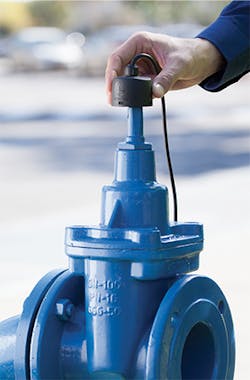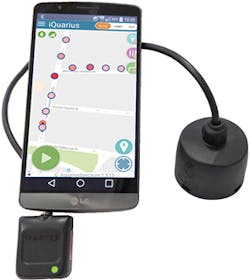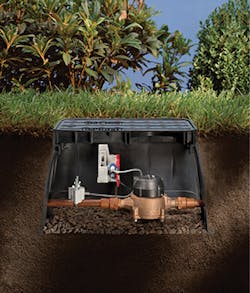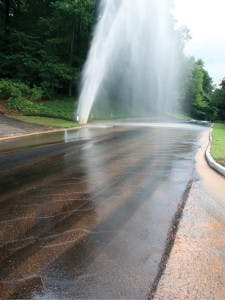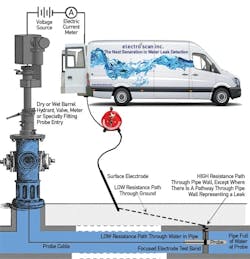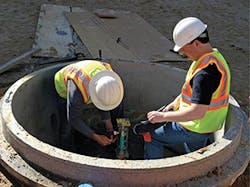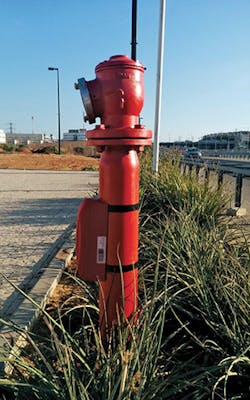Leak detection is one of the highest priorities of any water distribution system operator. Leaks are the result of structural failures to the containment integrity of a water supply system’s distribution pipe network. These failures can occur anywhere in the pipe system but mostly occur at pipe joints and fittings. They can occur at any time, even in newly constructed systems, but for the most part are a problem that plagues older pipe systems. They are the result of long-term degradation caused by corrosion of the pipe walls and fittings, medium-term structural damage from freezing or earth dislocation, and immediate impacts from shock caused by vehicles or equipment. Over time, if left unaddressed, leaks can result in significant loss of potential revenue to the water supply system, hence the accumulated losses from individual leaks being officially referred to as “non-revenue water losses.”
The questions then become: how can utilities be sure to select the right leak detection method to meet a system’s specific needs? What should the engineers and plant managers look for? Is there a set of best practices for selecting the best method for a distribution system?
ELEMENTS OF A WATER SUPPLY SYSTEM
A water supply system delivers water to the municipality it serves via a series of underground pipelines of various sizes and materials. The water originates from a regional source (groundwater well fields, manmade reservoirs created by dams or dikes, natural lakes and ponds, etc.) and is filtered of impurities prior to transmission. The motive power for the flow of water through the pipelines is a combination of gravity head from higher elevation and mechanical pressure head provided by pumps. Water reservoirs such as elevated tanks, lined ponds, etc., are used to handle surges in water demand, providing stored water for peak demand periods. The entire system is designed to provide water to each industry, business, and residential user in the required quantities under useable pressure.
The pipeline network consists of a series of pipes arranged in parallel and sequence of ever-smaller diameter pipes. These start with the large diameter water mains (which can be 10 feet or more in diameter) and proceed to smaller branch distribution pipelines, smaller diameter service pipelines, and finally feeder pipes to individual users (often as small as an inch in diameter). Each point of divergence from larger pipes to smaller pipes or parallel branch pipes is referred to as a node. Each node is typically an auxiliary structure or fixture supporting the main water transmission function of the pipeline (bends, valves, tees, wyes, flanges, etc.). Though cracks can occur in the walls of the pipes themselves, these nodes are the system’s potential weak points where breakage and leaks are most likely to occur—the weakest links in the chain. They are vulnerable to many forces that can act to cause a break (overburden, ice buildup, vibration, and shifting soils) since these forces get concentrated at the nodes. In addition to being subject to the most forces, nodes are typically weaker than the pipes they are connected to.
iQuarius leak detection survey via mobile acoustic sensor
Water pipelines and their associated fixtures are made from a variety of materials. Improvements in available materials over time can be reflected in the status of a large, older water distribution system with older portions of the system built from materials in popular use decades ago and recent additions or replacements utilizing more advanced materials. The result can be a hodge-podge of different types and materials and different vulnerability to leakage and structural failure. Ancient and medieval cities utilized hollowed out wooden logs or vitrified clay for water pipelines. The oldest water pipelines in North America were constructed from cast iron pipe, most of which have been replaced with more flexible and resilient ductile iron pipes. Currently popular is polyvinyl chloride (PVC) pipe which is mostly used for branch and distribution pipelines and reinforced concrete reserved for very large diameter water mains.
CAUSES AND CONSEQUENCES OF PIPELINE LEAKS
The primary cause of water main leaks, breaks, and failures is simple: time. Things wear out in time, especially water supply systems subject to potential physical dislocation and long-term corrosion. Many major cities have water supply system components going back more than a century. Sudden ruptures bubbling to the surface like a geyser may be dramatic but are very rare. These sudden mass losses of water can occur either from bursting pipes broken by the expansion of frozen water, a sudden shifting of surrounding soil like the creation of a sinkhole, or accidental damage caused by construction activities, excavation, or heavy vehicle traffic.
Water Pit 100 W
Most leakage occurs from slow moving damage caused by the accumulation of wear and tear over long periods of time. This is mostly due to corrosion and rust accumulation as well as differential settlement. This can cause damage directly to the pipe walls and containment structures of the pipe fixtures, but internal damage to seals and gaskets also occurs leading to containment breaches and joint dislocation. Blockage from clogging and accumulated sediment can prevent the proper functioning of valves and meters.
As a result, for a typical municipal water system, up to one third of its water is lost to leaks. Managing and anticipating potential leaks alone therefore has the potential to increase overall system efficiency by 50% (with an accompanying reduction in financial losses). Accurate assessment of existing leaks and other damage is critical to avoid wasting time and money fixing the wrong problem or problems with lower priorities.
So the first step is to accurately determine the location, nature, and extent of the leak. To do so requires continuous monitoring of the water supply pipeline network. The monitoring is intended to be proactive with modern monitoring systems being able to predict where leaks can occur with a high degree of accuracy. Being in an anticipatory mode allows a system operator to concentrate funds, labor, and equipment on the most vulnerable areas with the goal of preventing problems before they happen. This saves money two ways: efficiently using current resources and preventing future expenditures for repair. Saving money is especially important for municipal water supply systems whose budgets can have up to a third of its funding allocated for maintenance and repair. The savings can increase as a service territory expands and new segments of the water distribution system are added. Avoiding significant leakage can save money at many levels. It can reduce non-revenue water losses; save on production costs, pumping rates, and associated power requirements; minimize liability threats from cross contamination of the water supply; and help avoid damage to adjacent structures and overlaying streets.
A main break
LEAK DETECTION METHODS
As someone once said, we are given two ears and only one mouth because it is more important to listen than to speak. And listening is the key to water leak detection. Technically, leak detection is defined as “the systematic method of using listening equipment to survey the distribution system, identify leak sounds, and pinpoint the exact locations of hidden underground leaks.” But in practice this means simply listening for the sound of rushing water as it leaks from a pipeline while under pressure. For this purpose, acoustical listening devices—either mobile, manually operated sensors or permanent units mounted on pipelines and fixtures—are preferred. Leakage can also be indirectly located and measured by a series of flow meters or pressure gauges providing differential values for different segments of the pipeline being examined.
Sensors and other detection methods can be mobile or fixed, direct or indirect, external or internal, utilize radio transmittal of data, or require manual download. Fixed sensors typically are used to bracket the location of the leak while mobile listening devices are designed to travel down this bracketed segment looking to pinpoint the exact location of the leak. Indirect methods use pressure and flow measurements from across the system to perform statistical analyses of where the leaks are most likely located, while direct methods actively locate the physical location of the leaks by direct acoustical measurements. External methods listen for the noise made by leaks as they exit the pipe, while internal methods measure the characteristics (flow rate, flow velocity, water temperature, and pressure head) of the flow inside the pipes.
mLog online leak detection
MAJOR INDUSTRY SUPPLIERS
Echologics is all about information. This high-quality, actionable information about the status of water supply systems and other buried utilities optimizes infrastructure investments. It also maximizes the efficiency of repair efforts, rehabilitation programs, maintenance procedures, operational safety, and functional lifetimes. Getting accurate information on buried water main assets allows the system operator to prioritize capital spending, minimize the potential for leaks and pipeline breaks, and properly manage the challenges posed by aging water supply systems. To provide this information, Echologics performs a “water main condition assessment.” Water main condition assessments allow for the adoption of Condition Driven Asset Management (CDAM) programs. CDAMs are utilized to establish baseline water system conditions, plan for replacement and rehabilitation, provide justification for rate cases, and provide due diligence for review of water system acquisitions. CDAMs also provide a tiered approach for pipeline inspection and performing continuous monitoring of critical system elements. These assessments are performed by utilizing their advanced ePulse condition assessment technology. This technology utilizes a combination of acoustic signals and advanced computer algorithms to assign a grade of “good,” “moderate,” or “poor” of each assessed pipe segment.
Electric circuitry of a water main
Though primarily a manufacturer of flow meters for the industrial, oil and gas, and agriculture markets, McCrometer also makes leak detection meters specifically designed for municipal water supply pipelines. As a practical matter, this is an easy and straightforward way to determine, estimate, and even locate water leaks. By installing flow meters at key points throughout the water distribution system, their readings can provide the necessary information for hunting down water loss locations. By recording the flow rates in each section of the water supply pipe system any differences in flow measurements between two points can be considered the loss of leakage. Logically, the leak should be located between the two flow meters in question.
McCrometer’s Next Generation FPI MAG flow meter is a magnetic flow meter ideally suited for this task. The FPI Mag meter represents the next generation of development of magnetic flow meter technology and employs a unique and ground-breaking configuration whereby the coils and electrodes are assembled in a tube that inserts into a pipe perpendicular to the full profile of the flow stream. In fit and form the FPI Mag is unique. It can fit into pipes with diameters ranging from 4 inches to 138 inches. Its patented technology provides accurate readings within +0.5% and can be installed, removed, and operated while under static pressure head. This may seem trivial but the ability to install a flow meter without having to shut down the system provides significant cost savings to the operator. Direct insertion also avoids the time and money needed to reconfigure pipes or cut them to install and weld exterior flanges to house a flow meter.
American Leak Detection is a service firm that performs leak detection audits for industrial services and water distribution surveys, as well as the location of utility lines, property boundary management, infrared energy reporting, and trenchless pipe replacement. Their technicians provide complete leak surveys utilizing advanced correlation technology. In doing so, they can reduce liability and non-revenue water losses, minimize repair costs, and avoid system contaminating and backflow.
Aquarius Spectrum is a leading provider of advanced leak detection solutions for water loss reduction, burst prevention, and pipe condition assessment. Its technology can monitor an entire municipal water distribution network and detect underground leaks from the earliest stages of their development using both fixed and mobile acoustic sensors.
The comapny’s monitoring sensors can provide complete, real-time GIS mapping of every potential pipe network failure point. This provides the information needed for water network operators to focus their resources efficiently and effectively. The product line provides acoustic and hydrophone sensors for most pipe materials. Their AQS-SYS is a fixed leak detection system that executes daily monitoring of the municipal water network. Fixed installation of correlating sensors cover large networks of distribution and transmission pipes. The sensors are installed over ground on hydrants or underground in valve pits. Larger diameter pipes are equipped with hydrophones. Vibration sensors are used to monitor water mains and other distribution pipes. The sensors use cellular, 3G network for communication and are basically plug-and-play. Once in place, the system can identify the presence of leaks from a very early stage and trace their development over time. The cloud-based processing and algorithms provide reliable and accurate information on leak location over the pipe as well as estimation of intensity and growth rate. This information is used to prioritize leak repairs and pipe maintenance.
In addition to the permanent system, the iQuarius portable system is a mobile leak detection device connected to a smartphone, which interacts with its own proprietary app. It is a portable solution that integrates listening stick, ground sensor, and correlation sensors, providing high-end performance. By using iQuarius, the operation team can execute a manual leak survey to verify and pinpoint the exact location of a pipeline leak or rupture. The AQS system has been successfully used on over 1,200 miles of water pipelines in Israel, America, and Europe with some major municipal water systems achieving more than a 20% reduction in non-revenue water losses.
Electro Scan, Inc. is a leader in pipe condition assessment with its new multi-sensor probe that combines four different methods of leak detection into one unit. Electro Scan’s patent pending four-in-one multi-sensor probe, consists of the following: a low-voltage conductivity sensor (to measure individual leaks and total defect flows utilizing a low-voltage conductivity tri-electrode array and in doing so detect leaking cracks, pinholes, defective joints, bad service connections, and other openings to ground); a high-definition camera to navigate through water mains and visually record leak locations; a pressure sensor (used to detect defective flow rates); and an acoustic sensor to record sound vibrations to cross reference with other detection methods. “The Electro Scan four-in-one water probe was designed to find leaks not previously found by legacy methods,” states Mark Grabowski, general manager of Electro Scan. “If a pipe leaks electricity, it leaks water. Now we can provide a reliable, repeatable, and measurable solution for the water industry, based on our proven technology already being deployed in the wastewater collection industry.” By utilizing neutrally buoyant fiber optic cable Electro Scan can examine up to 2,000 linear feet of water main from a single access point.
Gutermann Leak Detection provides a wide range of products in all areas of traditional acoustic leak detection combined with their newly developed permanent network-monitoring technologies. This combined approach makes their system a leader in intelligent water-loss management. This is a holistic approach to leak detection. Its overarching method includes the use of permanent network monitoring technology in a water distribution network to track all leak-related events and non-events in one centralized management platform. This platform is a real-time system that allows an operator to follow through with events through managed event ticketing from alarm to repair. In doing so, the operator can gain complete transparency over the condition of the pipeline distribution network.
Installation of McCrometer’s FPIMag, a magnetic
flow meter.
The system works as follows: When an alarm is generated somewhere in the pipe network, the operator must first perform online analysis of the specified event. If necessary, the operator can go onsite and perform additional localization and leak detection work utilizing conventional acoustic listening sensors and equipment such as ground microphones and leak noise correlators. With this information, proper action can be taken to fix or monitor the problem (leak repair, pipe replacement, or only continuous surveillance of the leak). A description of the action(s) taken is fed back into the monitoring system in the form of data, providing information concerning the respective location, leak information, pipe data, or other information (such as previously unknown PRVs, electro generators, or leaky house connections). This adds further to the operator’s accumulated knowledge of the system over time. In addition to these special events, their permanent network monitoring sensors provide daily information (noise level histograms, frequency spectrum, correlation data, and actual sound recordings).
The technology Gutermann has used to create this system is as diverse as it is advanced. Their Aquascope product range includes acoustic leak sensors with some of the best amplification on the market. These include leak noise correlators—noted for long-term reliability and ease-of-use—whose applications range from standard situations to more difficult environments (including trunk main leak detection). To record the data from the leak noise correlators, Gutermann has its Zonescan 820 product line of leak noise loggers. Though small in size, they are equipped with high sensitivity, strong proprietary radio equipment, smart firmware, and long battery life. Their loggers not only provide noise level data and advanced spectrum analysis, but they can also correlate and are therefore able to pinpoint leaks with high accuracy. This locational accuracy is augmented by the use of their pipe and valve locators.
Cincinnati-based Fluid Conservation Systems (via Palmer Environmental Ltd. and its sister company Radcom Technologies Ltd.) provides a full range of leak detection instruments under the name “Halma Water Management.” Since 1979, when it developed the first leak noise correlator, Palmer has been a pioneer in acoustic noise logging and fixed network systems and today provides a full range of products including acoustic leak noise loggers, correlators, electronic ground microphones, mobile step testers, and pressure control equipment. Their Permalog enables water suppliers to locate leaks in the water network. These loggers are deployed in areas of the distribution system to provide continuous monitoring of leakage. They can be easily installed on pipe fittings and are retained in place by a strong magnet. Power is provided by low-cost replaceable batteries. Upon discovering a leak, the Permalog unit sounds an alarm and transmits a radio signal to indicate the failed condition. Capable of storing up to 29 days of data, the loggers are immersion-tested to IP68 and will continue to operate even in flooded chambers. They now include Aqualog extended logging functionality over extended periods of time. Data can be accessed by either direct removal from the ground and manual retrieval, radio transmittal to a roving vehicle, or direct entry into to a computer control system via a radio network.
A fixed acoustic sensor on a hydrant
Augmenting these set stations is their mobile, manually operated Lmic. Operated by a trigger and a volume-sensitive rotary control, the Lmic combines an electronic listening stick with a ground microphone. It is used for general leak sounding operations and can be configured for use as a ground microphone or equipped with probe rods which allow for sounding at fittings or in soft ground. This lightweight unit can be used to confirm the position of underground leaks acoustically from ground level and perform traditional acoustic surveys.
ITRON leak detection technologies, combined with their powerful analytical tools, are designed to take the guess work out of locating leaks. Utilizing ITRON’s leak detection solution will have an immediate impact on conservation programs, revenue and profitability projections, and overall operational efficiency. In short, it has a positive impact on any water supply system’s bottom-line. ITRON’s technology allows an operator to address potential leaks and catastrophic failures before they occur. Once in place, an operator can use their leak detection technology to remotely organize, interpret, and optimize demand-side and supply-side leak data in close intervals. Field personnel can then create proactive plans that will deal with emergent leaks as part of an overall detection and repair program. The system seamlessly integrates into daily water supply operations. The system operator will enjoy conservation and cost benefits even before the first leak is repaired.
ITRON’s solution has found widespread use across the country—from Providence Water in Rhode Island (which has leveraged ITRON technology to find and fix leaks, and to improve customer service), to Clayton County, Georgia (which is saving millions of gallons annually and becoming more operationally efficient). North Miami Beach deployed 38,000 smart communication modules and 11,000 acoustic leak sensors as a part of its ITRON solution—and is already collecting real-time data on usage and potential leaks. Because of ITRON technology, the city now knows within three days when a leak occurs instead of potentially taking more than a year to identify. Furthermore, ITRON’s water AMI solution enables North Miami Beach to enhance customer service, protect revenue, forecast consumption, analyze flow, and support district metering by leveraging detailed consumption and meter alerts collected by ITRON analytics.
